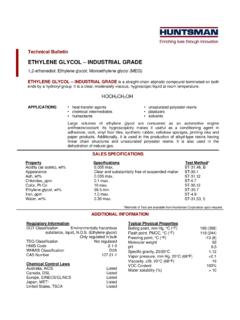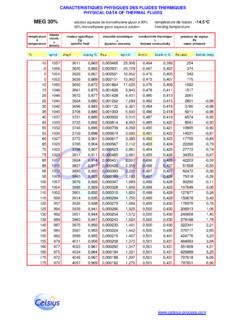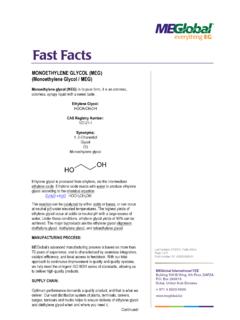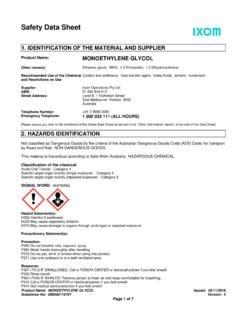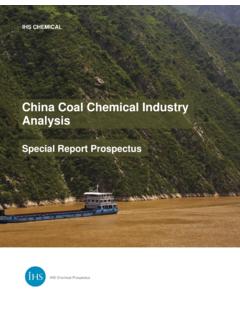Transcription of Antifreeze / coolant – Technical aspects. A Little History
1 April 2006 BTC06/637/C Antifreeze / coolant Technical aspects. This article is intended only to provide a general background on engine coolants. It is neither comprehensive nor definitive, nor is it intended to supplant any individual engine manufacturer s recommendations. A Little History As long ago as 1886 Carl Benz recognized that an absolutely critical part of any engine was the cooling system. As a rough rule of thumb, only about 28% of the thermal energy released by the combustion of fuel is converted into motion. About 7% is used to overcome friction in the engine, drive train, tyres etc. About 35% disappears out of the exhaust, and the remaining 30% has to be removed by the coolant or it will just heat up the engine. Clearly cooling the engine efficiently was critical to further development.
2 In terms of thermal efficiency the problem of cooling the engine could be solved by using water. It has excellent thermal conductivity and excellent heat capacity, but it has serious disadvantages; it freezes at relatively high temperatures, worse yet it expands by 9% when it freezes exerting tremendous pressure; it boils at relatively low temperatures, it is corrosive and may contain dissolved solids. All the advances in coolant technology have been directed at overcoming these disadvantages. Various materials could be added to water to lower the freezing point as shown in the table below: * monoethylene glycol However, all the resultant mixtures failed to meet one or more of the other key coolant requirements Good heat transfer properties Boiling point elevation Corrosion protection % weightcalcium chloridemethanol/glycerine glycerineabsolute alcoholtable salt methanolMEG* April 2006 BTC06/637/C In 1929 mixtures of monoethylene glycol (MEG) or monopropylene glycol (MPG) with water were found to have outstanding properties in terms of depressing freezing point.
3 They also significantly increased the boiling point, they had acceptable heat transfer properties, they did not evaporate like methanol, they could be treated with corrosion inhibitors and they were becoming available in large volumes as the petrochemical industry expanded. MEG has been the main component of Antifreeze coolant concentrates ever since. The Technical advances have been in the field of corrosion inhibitors, which have had to cope with changing metallurgy and increasing severity of operating conditions. The requirements of a modern coolant / Antifreeze are: Prevention of corrosion Excellent heat transfer Prevention of deposits Stability at high temperature Compatibility with hard water Compatibility with plastics and elastomers Low foaming tendency Freeze protection MEG This was originally chosen in preference to MPG because of better availability and lower cost.
4 The glycol makes up over 90% of the coolant concentrate. It depresses the freezing point and elevates the boiling point of water. The depression of freezing point is roughly proportional to the volume of glycol in the water up to a limit of about 55% as shown in the graph below. April 2006 BTC06/637/C MEG / MPG Freezing Point concentrate in waterdeg CMEGMPG The data points for the curve for MEG between 55 and 80% cannot be determined by this method. coolant concentration should never be more than 60% volume. CORROSION INHIBITORS These reduce corrosion. The volume of coolant concentrate added to the water controls the amount of inhibitors added. Motor manufacturers at first fill use between 40% and 50% of highly inhibited concentrate in water, and to get the full benefit of such long life coolants a minimum concentration of 40% must be maintained.
5 Basic concentrates meeting BS6580 are designed to provide adequate inhibitor concentrations for light duty at 33% volume in water. Even in temperate climate conditions and with regular changing the coolant concentration should not be allowed to fall below 33% for this reason. For frequency of coolant change and type of coolant to be used the vehicle manufacturer s guidelines should be followed. Historically three different approaches to corrosion inhibition developed in different parts of the world in response to differing market demands. Things like water quality, cooling system design and metallurgy, engine design and metallurgy, power output and load on the cooling system, severity of winters and so on all influenced the development of coolants in different markets. The dominant regions in vehicle manufacture have traditionally been the USA, April 2006 BTC06/637/C Europe and Japan, and so we see three different approaches to solving the problems of engine cooling.
6 If you look at what is common to the three regions (in italics) you see the basics of Organic Acid Technology (OAT) coolants as a proposed global approach. The development of organic acid technology coolants had two basic aims, to introduce a long life coolant into the market where an annual change was the norm and to have a world coolant . However not all vehicle manufacturers accepted this technology and there are some countries which have local restrictions on coolant properties that reduce the flexibility to have new types of coolant . Consequently the modern technologies are: Organic Acid Technology salts of organic acids, triazoles, possibly containing nitrate and molybdate Hybrid technology basically the traditional European silicate technology but may also contain nitrite and organic acids Japanese technology Combination of OAT and phosphate technologies As a general principle these technologies should not be mixed.
7 BTC has developed a simple classification system so that containers can be marked to show which technology has been used. A full explanation can be found on the BTC website, but in essence there are numbers 0 to 5 to classify the main inhibitor package followed by E or P to show Ethylene or Propylene glycol and finally the letter N if nitrite is present. USA Europe Japan Silicate Silicate Phosphate Phosphate Salts of organic acids Salts of Organic Acids Salts of Organic Acids Amines Triazoles Triazoles Triazoles Nitrate Nitrate Nitrite Nitrite Borate Borate Molybdate Molybdate April 2006
8 BTC06/637/C OTHER ADDITIVES Additives to inhibit scale formation are used. These could be sequesterants and / or polymeric dispersants and are the kind of products commonly found in water treatment to inhibit the effects of hard water. Silicate stabilisers are often used to reduce the tendency of silicates to precipitate under extreme conditions of use. Anti foaming agents are commonly used to reduce air entrainment in the Antifreeze which could lead to cavitation problems and difficulties in the packaging process. A range of dyes are normally added for identification OAT technology products are often though not exclusively red or orange. Denatonium benzoate is often used as a bittering agent to make coolants taste bitter and unpalatable. HEAVY DUTY APPLICATIONS This refers to diesel or gas engines often of large displacement running under high load or continuous operation.
9 Examples are marine engines, power generation, trucks, buses, construction equipment and so on. Service life is best measured in hours of operation or mileage travelled rather than years because of the wide variation in operating conditions. In power generation regular condition monitoring of the coolant is often the best way to maximise coolant life and minimise cooling system corrosion. Static engines are often in banks with a central coolant reservoir, the load on the coolant is very different from a transport application. A particular design feature of these big engines is that many have wet liners and are prone to a phenomenon called wet liner cavitation. The shock wave from combustion causes vibration in the liner which in turn promotes local boiling of the coolant . The bubbles of vapour expand until the pressure of the liquid causes them to collapse.
10 A small jet of liquid shooting into the collapsing bubble hits the metal surface hard enough to have a physical effect. The cumulative effect is a bit like water-blasting the surface and if the coolant inhibitors are not good enough the surface is eroded very quickly. In Europe coolants have typically been fully-formulated to cope with this, in the USA until relatively recently the approach was to take a basic light duty coolant and treat it with a Supplemental coolant Additive package to boost the additive levels so that protection against cavitation was provided. Booster treatments were used at regular intervals to maintain the additive levels and extend the coolant life. These treatments were in the form of tablets or liquids or even impregnated filters. In general American engine manufacturers still require the use of the booster SCAs for in-service coolant quality maintenance, though most now require the use of fully formulated coolants at initial fill or coolant change.

